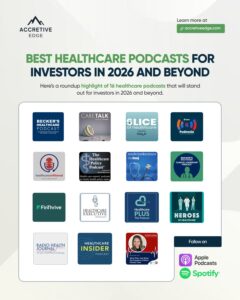Founders often carry the burden of early sales themselves, but at a certain point they face a ceiling. Investors, too, are aware that strong science or clever software alone won’t drive adoption — a clear go-to-market strategy is essential.
In response, more CEOs and boards are turning to fractional go-to-market (GTM) leaders. This model allows companies to bring in seasoned commercial expertise without the cost or commitment of a full-time executive. It is gaining traction in digital health, but many leaders remain unclear about what it actually entails, when to use it, and how it differs from both consultants and permanent hires.
This article will break down the role of the fractional GTM leader, explain when the model makes the most sense, and set expectations for what CEOs and investors can gain from it.
Who is a Fractional GTM Leader?
A fractional GTM leader is a senior commercial executive — often with experience as a VP of sales, chief marketing officer, or chief revenue officer — who works with a company on a part-time or project basis. Instead of joining full-time, they embed for a defined period, usually a few months, to help build or accelerate the company’s go-to-market approach.
Their role is broader than that of a consultant. Consultants often analyze, recommend, and step away. A fractional leader, by contrast, is hands-on and accountable. They work inside the company, making sales calls, shaping pricing, building processes, and mentoring early commercial hires. The expectation is that once the foundation is in place, the role transitions to a full-time executive who can scale the team.
Fractional leadership also differs from simply hiring an advisor. Advisors may provide valuable introductions or act as sounding boards, but they rarely own deliverables. A fractional GTM leader takes responsibility for outcomes, whether that means refining product-market fit, securing early contracts, or preparing the organization for its first full-time commercial leader.
Signs Your Company Needs a Fractional GTM Leader
Fractional GTM leadership becomes most valuable at critical transition points in a company’s growth. These are the moments when strong products and early traction collide with the complexity of healthcare markets, and when experience matters most.
For young companies, the shift away from founder-led sales is often the first signal. Founders can secure early pilots through their networks, but scaling requires structure. This was the case with Google’s Care Studio and its AI-driven analytics platform. The products were strong, but they created confusion across internal business units and had no dedicated sales function. By clarifying positioning, aligning stakeholders, and embedding the products into an existing sales organization, fractional leadership ensured the solutions could move into the market without undermining broader priorities.
Another signal comes when a company is ready to build its first commercial team. Funding may be in place and early traction secured, but without experience, it’s easy to misjudge which roles to prioritize or how to structure them. Consolidate Health faced this exact moment. The company had a strong product and engineering base but no marketing or sales function. Rather than rushing into full-time hires, they brought in fractional leadership to map the org design, select tools, and run the first campaigns. Acting as part of the team, the fractional leader created the structure and processes that allowed early hires to succeed, while saving the company from costly missteps.
For companies entering regulated markets, the inflection point comes when commercialization collides with compliance. Verily faced this challenge with a Class II regulated software device that required strict adherence to FDA guidelines and federal procurement rules. By building compliant marketing materials and aligning sales enablement with regulatory labeling, fractional leadership gave the company a pathway into government and enterprise markets while staying within legal guardrails.
Growth-stage companies preparing for an acquisition face a different need. At this stage, products often need to serve multiple buyer groups or adapt to shifts in purchasing dynamics. Fractional leadership can guide product and commercial adjustments, helping companies broaden their market reach, secure larger contracts, and position themselves for a stronger valuation at exit.
Even later, after major investments or acquisitions, fractional leadership can be critical. When multiple product lines or business units need to be integrated, a fractional GTM leader can help unify the commercial story, develop new offerings that span portfolios, and create models for recurring revenue. By validating market demand and equipping the board with clear ROI evidence, they help ensure that investments deliver on their promise.
In each case, the common thread is timing. Fractional GTM leadership steps in when the stakes are high and the path forward is uncertain, helping companies prove readiness and unlock growth without overextending resources.
What to Expect From a Fractional GTM Leader
A fractional GTM leader is more than a strategist. The real value comes from blending high-level planning with day-to-day execution. Companies can expect three main categories of impact:
Strategic deliverables
Fractional leaders often begin by clarifying the fundamentals: defining target customer segments, refining product-market fit, building messaging frameworks, and setting pricing and packaging strategies. These deliverables form the foundation for scalable growth and are often captured in a GTM playbook.
Executional deliverables
Unlike consultants, fractional leaders don’t just write recommendations — they execute. This might include joining early sales calls, setting up customer feedback loops, drafting the first sales materials, recruiting and mentoring commercial hires, and building dashboards for pipeline visibility. In some cases, they even lead negotiations for early pilots or partnerships.
Organizational impact
Fractional leaders also act as a bridge between product, clinical, and commercial teams. In healthcare especially, where technical teams and business stakeholders may not naturally align, a fractional GTM leader can create shared understanding and focus. Their cross-functional work helps avoid internal bottlenecks and accelerates decision-making.
Taken together, these contributions allow a company to test, refine, and prove its go-to-market model before committing to a full-time executive hire.
Fractional GTM vs Consultants vs Full-Time Executives
Fractional GTM leadership is often confused with consulting or interim executive work, but there are important differences.
Compared to consulting
Consultants typically analyze a problem, recommend a solution, and leave execution to the client. Their work is valuable for insights, but they are rarely accountable for results. A fractional GTM leader, by contrast, embeds directly in the business. They make sales calls, build pricing models, hire team members, and create repeatable processes. Their success is measured by outcomes, not just deliverables.
Compared to full-time executives
A full-time commercial leader has broad responsibilities, from revenue ownership to team management, and requires a long-term financial commitment. By contrast, a fractional GTM leader focuses on solving immediate growth hurdles at a lower cost. They work part-time — often one to three days per week — and are expected to hand off to a permanent hire once the foundation is in place. In fact, companies can save up to 40%, making it a financially efficient bridge option.
A bridge model
In practice, fractional GTM leadership serves as a bridge. It provides the senior-level experience companies need to establish a strong commercial base, without the risk of hiring too early. Full-time hires also carry risk: in many industries, CMOs and CROs stay less than four years on average, which can disrupt momentum if the fit isn’t right.
By starting with a fractional GTM leader, companies reduce the risk of mis-hiring too early and instead build the right foundation before investing in a permanent executive. Once the company reaches the right stage of growth, the fractional leader can transition responsibilities to a full-time executive who is set up for success.
The Investor and CEO Perspective on Fractional GTM Leaders
Fractional GTM leadership is not just a short-term fix. For both CEOs and investors, it offers a way to reduce risk while accelerating growth.
For CEOs
Founders often carry the burden of early sales, which can distract from product development and operations. A fractional GTM leader steps in to own commercialization, freeing the CEO to focus on vision and execution. Because the engagement is flexible and time-bound, it avoids the risk of bringing in a full-time CRO or CMO before the company is ready.
For investors
Investors want to see proof that a company can grow before they commit further capital or recruit permanent leadership. Fractional GTM leaders provide that validation. They can demonstrate product-market fit, secure early contracts, or refine pricing models that increase enterprise value. In some cases, they directly prepare a company for exit by strengthening its commercial story.
By giving both CEOs and boards greater confidence, fractional GTM leadership ensures that commercialization is not an afterthought but a deliberate, staged process.
Final Thoughts on Fractional GTM Leadership
Fractional GTM leadership is not a stopgap, but a strategic option. When companies find themselves at a critical growth moment — whether moving beyond founder-led sales, entering regulated markets, preparing for exit, or scaling post-investment — it may be the right time to bring in a fractional GTM leader.
If you want an outside view on whether this model fits your stage, I’m happy to be a sounding board. We’ll look at where you are today, what’s blocking growth, and what a practical next step could look like. Let’s talk.






